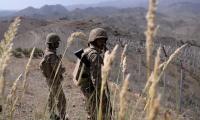As of the year 2006, Fidel Castro, Cuba’s revolutionary leader, who has died aged 90, had reportedly been the subject of no fewer than 638 assassination plots by the CIA.
The Guardian newspaper notes that these had ranged from mundane bombing and shoot-’em-up schemes to more ludicrous proposals, such as one involving “a diving-suit to be prepared for him that would be infected with a fungus that would cause a chronic and debilitating skin disease”.
At first glance, of course, it may seem odd and overreactive that a global superpower would engage in neurotic efforts for over half of a century to take out the leadership of an island nation smaller than the US state of Pennsylvania.
The campaign to demonise Castro by associating him with apocalyptic scenarios, however, fails to account for the fact that the US undoubtedly takes the cake when it comes to existential threats - i.e. threats to existence as we know it. The Cuban Missile Crisis, for example, is recorded in official US propaganda as the time the Soviets brought the world to the brink of nuclear war by installing ballistic missiles in Cuba.
In reality, the installation of said missiles postdated the installation in Turkey of US nuclear-armed Jupiter missiles pointed at the Soviet Union, and amid a US terror offensive courtesy of President Kennedy in Cuba, where Soviet missiles constituted the only deterrent against an invasion to topple Castro.
The sheer disingenuousness of the Cuban-freedom alibi is further underscored by the fact that the US happens to occupy a portion of Cuban territory on which it presides over an illegal prison dedicated to indefinitely detaining, torturing, force-feeding, and otherwise annihilating the freedoms of various non-Cubans.
To be sure, Castro’s Cuba was never a paragon of freedom of speech or related rights. When I visited for a month in 2006, some of the government detractors with whom I spoke would only pronounce Castro’s name in a whisper.
Others had no qualms airing their complaints at high volumes, such as my father’s relatives in the eastern province of Granma, who claimed that Castro was personally to blame for their inability to remodel the bathroom since 1962.
Although Cuba does not qualify as an objectively free society, it’s important to recall that curtailments to Cuban freedom do not occur in a vacuum. Instead, they occur on an exposed island that has, for the duration of its contemporary history, resided in imperial crosshairs.
Given the sustained US effort to overthrow the Castro regime, and the system itself, with the help of fanatical Cuban exiles prone to terrorism and sabotage, state paranoia has perhaps not been unfounded. Repressive security measures stemming there from qualify as reactive in nature, and a result of vindictive US policy.
There are, meanwhile, numerous freedoms Castro’s Cuba hasn’t skimped on. There’s much to be said, for example, for the freedom to exist without having to worry about access to food, shelter, healthcare, and education - all of which the Cuban state provides its residents.
Despite spending a fraction of what the US was then spending per capita, Cuba enjoyed a lower infant mortality rate than its neighbour to the north - not to mention one of the highest ratios of doctors per capita in the world. Instead of exporting catastrophe, Castro’s Cuba has focused on exporting doctors. The New York Times reported in 2009 that, “[i]n the 50 years since the revolution, Cuba has sent more than 185,000 health professionals on medical missions to at least 103 countries”.
Such achievements are all the more notable given that they have occurred within a context characterised by imperial predations, a punishing economic embargo, and politically influential, belligerent hysterics from the Cuban exile crowd headquartered in Florida, a mere 160 km from the Cuban coast.
It is within this context that Fidel’s legacy must be analysed. And it is this context that grants him legitimacy as a symbol of resistance against hegemony.
The article has been excerpted from: ‘Fidel Castro in context’.
Courtesy: Aljazeera.com
India uses Afghanistan as a backstage area to carry out terrorist attacks against Pakistan
Another report by the Pakistan Institute of Peace Studies states that 78 per cent of attacks have been carried out by...
Pakistan stands at the forefront of this crisis, generating a staggering 3.3 million tonnes of plastic waste annually
Today, a total of 11,000 children are attending Daanish schools in Punjab
The emotional instability of parents inculcates a range of psychological issues in children
The current way of dealing with the environment and climate change is no longer adequate







